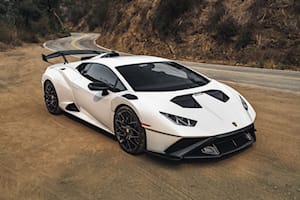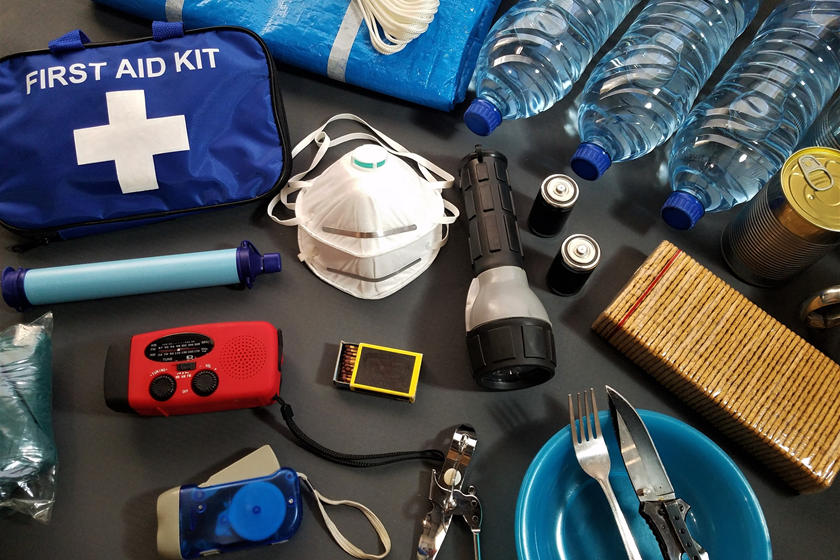An era is drawing to a close so let's take a closer look at one of Lamborghini's greatest.
As the end of the life cycle of the Huracan supercar comes into sight, Lamborghini is unleashing a slew of new models and special editions as a fitting farewell to the V10-powered supercar. At this point, there's a version of the Huracan for anyone that can afford one. But when it arrived in 2014 as a replacement for the Gallardo, it was an all-wheel-drive coupe only. A convertible joined the ranks two years later, and shortly thereafter, rear-wheel-drive versions of the two body styles appeared, albeit with less power.
As is tradition for Lamborghini, the Huracan is named after a fighting bull. In this case, 'Huracan' is the Spanish word for a Hurricane, the name of a bull from 1879 famed for its courage and strong sense of attack. Unlike its namesake, the mainstream Huracan's demise won't be as a result of multiple stab wounds for the pleasure of the crowd, but rather a shifting automotive climate that's moving away from combustion. However, it will become a classic as it is everything a Lamborghini should be; loud, visually stimulating, and incredibly rapid - a feast for the senses in almost every way. Here's everything you need to know about the Huracan before it meets its end.
When the Huracan was unleashed on the world in 2014, it promptly sold well and got positive reviews because, well, it's a Lamborghini, and people got excited for a new model. However, the Huracan wasn't wholly celebrated on its debut. Some, including Richard Hammond on Top Gear, found the styling to be subdued for a Lambo and saw it as a decision made to make the car easier to sell in more significant numbers than the Gallardo. Hammond also lamented that the Huracan wasn't as outright bonkers in its power delivery and handling as models before and that he adored. Complaints of excessive understeer also came to the fore. This was fixed in 2016 when Lamborghini made some adjustments and said the all-wheel-drive system to "provide a neutral and even more improved driving behavior, particularly in STRADA mode."
Then there was the Lamborghini Dynamic Steering (LDS) system, which is an option that varies the steering ratio based on speed, with complaints being leveled that it felt unnatural and even digital. In 2016, the system was updated, and, while track junkies still abhor it, many regular owners now like the system, and it genuinely makes parking easy. However, it was the introduction of the EVO model refresh in 2019 when the Huracan became its best self.
As of the 2019 refresh, the core Huracan models Became EVOs, as in the current range of the Huracan EVO, the Huracan EVO Spyder, the Huracan EVO RWD, the Huracan EVO RWD Spyder. With the introduction of EVO, Lamborghini also got rid of the confusing alphanumeric LP-XXX nomenclature. According to Lamborghini, EVO stands for the "evolution of the most successful V10-powered Lamborghini ever." And it is an evolution. We'll come to the engine in a moment, but the Huracan EVO also evolved in that the Performante model's rear diffuser and torque-vectoring system, radiators, exhaust routing, and rear-wheel steering became standard. It also gained a larger 8.4-inch infotainment screen and the rear-wheel-drive variants got a bump in horsepower.
Consistent through the Huracan's lifecycle has been the 5.2-liter naturally aspirated Audi/Lamborghini V10 engine carried over from the Gallardo. It entered its new lease on life with 602 horsepower and 413 lb-ft of torque in AWD form while sounding like the rhythm section of Led Zeppelin tuned the exhaust. The following rear-wheel-drive models arrived with less horsepower, 572 to be exact, but sounded no less exciting. When the track-oriented Performante debuted in 2017, power was cranked to 631 hp and 443 lb-ft. In 2019, the Huracan Evo and Spyder arrived as facelift models sharing the engine and technology from the Performante and taking the baton as it bowed out. Out of the gate, the Huracan LP610-4 Coupe was capable of hitting 62 mph in 3.2 seconds, while the Performante version can crack 62 mph in 2.9 seconds - still the quickest Huracan to this day.
Typically, the Huracan uses a seven-speed dual-clutch transmission with three modes (STRADA, SPORT, and CORSA). A manual transmission was never offered for the Huracan because, well, it's a 21st-century supercar, and someone with a manual can't beat its auto system.
Lamborghini falls under the Volkswagen Group umbrella. So, when its corporate cousin, Audi, decided a supercar would be a good idea it turned to Lamborghini's Modular Sports System platform. In other words, the Audi R8 shares the chassis and engine from the Lamborghini Huracan. Even the all-wheel-drive systems are fundamentally the same, albeit programmed differently. However, Audi never got the same outputs as the Lambo did, and none of the cool aerodynamic trickery went the way of the Four Rings, either. In terms of concept, styling, and execution the two cars are completely different animals. Despite coming after after the Huacan, the R8 feels like its older, more serious and sophisticated sibling.
An engine destined to become legendary needs the rest of the car to be able to maximize its power. An aluminum chassis with a center tunnel and rear bulkhead made from carbon fiber provides rigidity while keeping the weight low, while Lamborghini simplified the aero compared to the Gallardo while both lowering the drag coefficient and improving downforce dramatically - which is one hell of a trick. Add that to the (optional at first) magnetorheological suspension and the Huracan is a beast. Then the Performante came along.
For the Performante, Lamborghini reworked the engine and chassis to create something that took the Huracan to another level. Lamborghini put its freshly patented forged carbon fiber material to use with new active aerodynamics called Aerodinamica Lamborghini Attiva, or ALA for short. the first thing Lamborghini did with the Performante was take it to the Nurburgring and smash the production car record set by Porsche with the 918 Spyder.
When Lamborghini took the Huracan Performante to the Nurburgring, the 6:52.01 time claimed and shown in a video was 4.9 seconds faster than the longstanding record set by the Porsche 918 Spyder, Almost immediately, there was controversy over the time. The fact Lamborghini showed a video using two cameras in the car was catnip to the doubters, and then people started comparing the Performante's run to a previous run by the same driver setting a time of 6:59.73 in an Aventador LP750-4 Superveloce. According to the critics, you can see the Aventador hitting higher speeds between corners, and mixed with anomalies in the video, serious doubt was cast. Even Christian von Koenigsegg weighed in, saying "So slow in the the straights, yet it looks like it's on rails in the corners, and there's no G-force meter. If you have that kind of cornering capabilities, why don't you show your G-force, like everybody else?" In response, Lamborghini showed the VBox GPS log to journalistsand pointed out speed in a straight-line isn't an indicator of a lap time. It had a point, otherwise there would be no need for corners on a race track.
Lamborghini isn't as well known as its contemporaries for racing, and with good reason. However, the brand is heavily involved in the GT3 class on top of having the one-make Super Trofeo race series, and that spawned the Huracan STO (Super Trofeo Omologata). If your idea of a pure supercar is one bred from the racetrack to drive on the street as well, the Lamborghini Huracan STO is a pitch-perfect example and one of Lamborghini's finest cars to date. It borrows from the Huracan GT3 EVO and Super Trofeo Evo race cars but manages to be toned down without being subdued, and we discovered just how incredible it is to drive. It weighs 2,952 pounds dry, lays down 630 hp to the rear wheels only, and delivers 926 pounds of downforce at 174 mph. It's stripped-down but comfortable. It's furiously fast, wails like a Lamborghini should, and handles like a well-balanced Japanese katana, yet it's not a chore in traffic and wouldn't be uncomfortable or annoying on a cross-country drive to experience a new racetrack.
When Lamborghini posted its best sales figures to date this year, it was the Huracan that tipped it over the edge. It is now Lamborghini's best-selling vehicle, with 20,000 units sold in total as of April 2022. That's over 6,000 sales more than the Gallardo ever achieved, and the Huracan still has a little time on the clock. According to Lamborghini, 71 percent of Huracan buyers choose the coupe, 32 percent of sales have been here in the US, and 60 percent sold were customized through the company's Ad Personam program. The 20,000th Huracan sold was an STO finished in Grigio Acheso Matt paint and now resides in Monaco. We're sure the Urus will overtake it in time, but 20,000 V10-powered supercars is nothing to scoff at, and just 15 years ago, Lamborghini could only dream of such numbers.
With the rise of off-road vehicles into the mainstream, it's inevitable there will be a niche for off-road biased supercars. One way this is possible is through a recently developed technology that's ready for prime time - 3D printing. Lamborghini is testing the waters with its Huracan Sterrato model. At the time of writing, it's still a concept, but it looks like there will be a production version before the Huracan makes way for a new car. The concept was announced in 2019, but photos recently leaked of what is likely the production version. This will likely pack the same 631 hp as the STO and Huracan Tecnica, but with AWD, raised ride height, and some badass styling to make it the rich man's rally tool.
Sadly, the Huracan will probably be the last V10 Lamborghini model as both the Aventador and Huracan's successors will likely be plug-in hybrids. While it may have had a rough start, it has now become a modern-day icon for the Raging Bull and one we'll remember fondly for years to come.









Join The Discussion